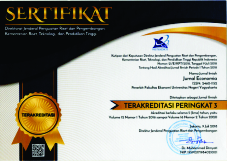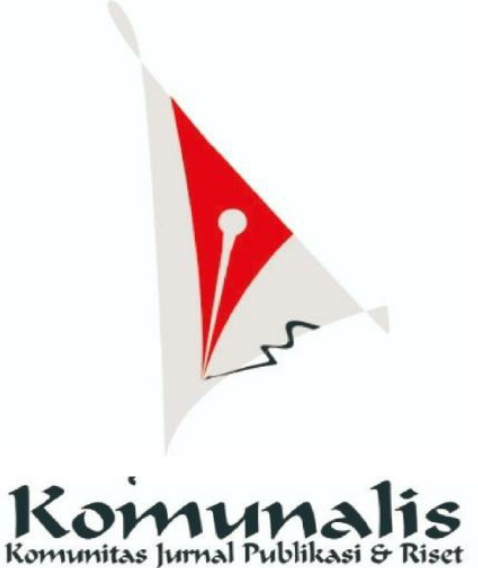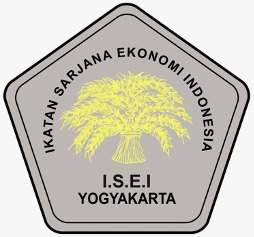The Role of Product and Service Quality in A Competitive Position: Depositors' Satisfaction
Downloads
Abstract
The study seeks how the Regional Development Banks operating in South and West Sulawesi maintain and attract depositors by evaluating the deposit products and banking service quality that have an impact on depositors' satisfaction. The study collected data using questionnaires distributed to 100 depositors owned by three Regional Development Banks. The data collected is then used to analyze the constructs of savings products, quality of banking services, and satisfaction using factor analysis to ensure that the five indicators proposed for each construct are eligible to be analyzed using the Structural Equation Model (SEM) method. The study found that the construction of deposit products and service quality have a positive impact on depositors' satisfaction with a dominant impact on deposit products. Banking service quality delivered by RDBs can attract deposit consumers as they have already convenience with the products and service quality
Keywords:Product Quality, Product Features, Service Quality, Depositors' Satisfaction
Peran Produk dan Kualitas Layanan dalam Daya Saing: Studi Kasus tentang Kepuasan Nasabah
Abstrak
Penelitian ini mengumpulkan data 100 simpanan pada tiga Bank Pembangunan Daerah. Data yang terkumpul kemudian digunakan untuk menganalisis konstruk produk tabungan, kualitas layanan perbankan, dan kepuasan menggunakan analisis faktor untuk memastikan bahwa kelima indikator yang diajukan untuk setiap konstruk memenuhi syarat untuk dianalisis menggunakan metode Structural Equation Model (SEM). Temuan menunjukkan bahwa, kecuali daya tanggap untuk konstruk kualitas layanan perbankan, semua variabel terukur dikatakan dapat mendefinisikan konstruknya. Lebih lanjut, konstruksi produk simpanan dan kualitas layanan berpengaruh positif terhadap kepuasan nasabah dengan dampak dominan terhadap produk simpanan. Artinya, fitur-fitur yang ditawarkan dan kualitas layanan perbankan yang diberikan oleh BPD dapat menarik minat nasabah simpanan karena sudah memiliki kemudahan dengan kualitas produk dan layanan..
Kata kunci: Kualitas produk, fitur produk, kualitas pelayanan, kepuasan nasabah.
Downloads
Akram, U., Hui, P., Kaleem Khan, M., Tanveer, Y., Mehmood, K., & Ahmad, W. (2018). How website quality affects online impulse buying: Moderating effects of sales promotion and credit card use. Asia Pacific Journal of Marketing and Logistics, 30(1), 235–256. https://doi.org/10.1108/APJML-04-2017-0073
Ali, M., & Raza, S. A. (2017). Service quality perception and customer satisfaction in Islamic banks of Pakistan: the modified SERVQUAL model. Total Quality Management and Business Excellence, 28(5–6), 559–577. https://doi.org/10.1080/14783363.2015.1100517
Amron, A., & Usman, U. (2016). Customer satisfaction in the marketing of inland transit insurance service. International Journal of Applied Business and Economic Research, 14(12), 8311–8321.
Bonner, C., Lelyveld, I. van, & Zymek, R. (2014). Banks' Liquidity Buffers and the Role of Liquidity Regulation. Journal of Financial Services Research.
Boonlertvanich, K. (2019). Service quality, satisfaction, trust, and loyalty: the moderating role of main-bank and wealth status. International Journal of Bank Marketing, 37(1), 278–302. https://doi.org/10.1108/IJBM-02-2018-0021
Chen, C. H., Nguyen, B., Klaus, P. "Phil," & Wu, M. S. (2015). Exploring Electronic Word-of-Mouth (eWOM) in The Consumer Purchase Decision-Making Process: The Case of Online Holidays – Evidence from United Kingdom (UK) Consumers. Journal of Travel and Tourism Marketing, 32(8), 953–970. https://doi.org/10.1080/10548408.2014.956165
Cohen, J. (1988). Statistical Power Analysis for the Behavioural Science (2nd ed.).
Dubrovski, D. (2001). The role of customer satisfaction in achieving business excellence. Total Quality Management and Business Excellence.
Hair, J. F., Black, W. C., Babin, B. J., & Anderson, R. E. (2010). Multivariate data analysis: A global perspective. Pearson custom library.
Hati, S. R. H., Gayatri, G., & Indraswari, K. D. (2021). Migration (Hijra) to Islamic bank based on push–pull–mooring theory: a services marketing mix perspective. Journal of Islamic Marketing, 12(8).
Henrique, J. L., & de Matos, C. A. (2015). The influence of personal values and demographic variables on customer loyalty in the banking industry. Marketing Intelligence and Planning.
Herrmann, A., Huber, F., & Braunstein, C. (2000). Market-driven product and service design: Bridging the gap between customer needs, quality management, and customer satisfaction. International Journal of Production Economics, 66(1), 77–96. https://doi.org/10.1016/S0925-5273(99)00114-0
Hossain, M. A., Dwivedi, Y. K., & Naseem, S. B. (2015). Developing and validating a hierarchical model of service quality of retail banks. Total Quality Management and Business Excellence, 26(5–6), 534–549. https://doi.org/10.1080/14783363.2013.856545
Hoyle, R. H., & Gottfredson, N. C. (2015). Sample Size Considerations in Prevention Research Applications of Multilevel Modeling and Structural Equation Modeling. Prevention Science, 16(7), 987–996. https://doi.org/10.1007/s11121-014-0489-8
Hsu, S. H. (2008). Developing an index for online customer satisfaction: Adaptation of American Customer Satisfaction Index. Expert Systems with Applications.
Hu, L. T., & Bentler, P. M. (1999). Cutoff criteria for fit indexes in covariance structure analysis: Conventional criteria versus new alternatives. Structural Equation Modeling, 6(1), 1–55. https://doi.org/10.1080/10705519909540118
Igbaria, M., Zinatelli, N., Cragg, P., & Cavaye, A. L. M. (2006). Personal Computing Acceptance Factors in Small Firms: A Structural Equation Model. MIS Quarterly.
Islam, R., Ahmed, S., Rahman, M., & Al Asheq, A. (2021). Determinants of service quality and its effect on customer satisfaction and loyalty: an empirical study of private banking sector. TQM Journal, 33(6).
Karimi, S., Papamichail, K. N., & Holland, C. P. (2015). The effect of prior knowledge and decision-making style on the online purchase decision-making process: A typology of consumer shopping behaviour. Decision Support Systems, 77(2015), 137–147. https://doi.org/10.1016/j.dss.2015.06.004
Kartika, T., Firdaus, A., & Najib, M. (2020). Contrasting the drivers of customer loyalty; financing and depositor customer, single and dual customer, in Indonesian Islamic bank. Journal of Islamic Marketing, 11(4), 933–959. https://doi.org/10.1108/JIMA-04-2017-0040
Kaura, V., Prasad, C. S. D., & Sharma, S. (2015). Service quality, service convenience, price and fairness, customer loyalty, and the mediating role of customer satisfaction. Marketing Intelligence and Planning.
Khan, M. S., Scheule, H., & Wu, E. (2017). Funding liquidity and bank risk taking. Journal of Banking and Finance.
Kotler, P. (2000). Marketing Management (Millenium).
Lamichhane, P. (2020). Depositors' perception on performance in Nepalese commercial banks. Management Dynamics, 23(1), 21–36. https://doi.org/10.3126/md.v23i1.35541
Lee, S. P., & Moghavvemi, S. (2015). The dimension of service quality and its impact on customer satisfaction, trust, and loyalty: A case of Malaysian banks. Asian Journal of Business and Accounting, 8(2), 91–121.
McDonald, R. P., & Ho, M. H. R. (2002). Principles and practice in reporting structural equation analyses. Psychological Methods, 7(1), 64–82. https://doi.org/10.1037/1082-989X.7.1.64
Mohd Suki, N. (2016). Consumer environmental concern and green product purchase in Malaysia: structural effects of consumption values. Journal of Cleaner Production.
Murdifin, I., Nasir, M., Ashoer, M., & Syahnur, M. H. (2021). Determination of Internet Banking Customer Satisfaction - Study at SOE Bank in Indonesia. Jurnal Minds: Manajemen Ide Dan Inspirasi, 8(1), 127. https://doi.org/10.24252/minds.v8i1.20640
Olsen, L. L., & Johnson, M. D. (2003). Service Equity, Satisfaction, and Loyalty: From Transaction-Specific to Cumulative Evaluations. Journal of Service Research, 5(3), 184–195.
Parawansa, D. A. S. (2018). Effect of commitment and customers' satisfaction on the relationship between service quality and customer retention in rural banks in Makassar, Indonesia. Journal of Management Development.
Paul, J., Mittal, A., & Srivastav, G. (2016). Impact of service quality on customer satisfaction in private and public sector banks. International Journal of Bank Marketing, 34(5), 606–622. https://doi.org/10.1108/IJBM-03-2015-0030
Putra, E. H., Hati, S. R. H., & Sri, D. (2016). Understanding muslim customer satisfaction with halal destinations: The effects of traditional and islamic values. 3rd International Conference on Business and Economics: Future Academy. www.FutureAcademy.org.uk
Quyet, T. Van, Vinh, N. Q., & Chang, T. (2015). Service Quality Effects on Customer Satisfaction in Banking Industry. International Journal of U- and e-Service, Science and Technology, 8(8), 199–206. https://doi.org/10.14257/ijunesst.2015.8.8.20
Raza, S. A., Umer, A., Qureshi, M. A., & Dahri, A. S. (2020). Internet banking service quality, e-customer satisfaction and loyalty: the modified e-SERVQUAL model. TQM Journal, 32(6), 1443–1466. https://doi.org/10.1108/TQM-02-2020-0019
Razak, I., & Nirwanto, N. (2016). The impact of product quality and price on customer. Journal of Marketing and Consumer Satisfaction, 30(2012), 59–68.
Saleem, B. A., Ghafar, A., Ibrahim, M., Yousuf, M., & Ahmed, N. (2015). Product Perceived Quality and Purchase Intention withConsumer Satisfaction. Global Journal of Management and Business Research: E Marketing, 15(1), p21-28. https://globaljournals.org/GJMBR_Volume15/3-Product-Perceived-Quality.pdf
Saunders, M., Lewis, P., & Thornhill, A. (2007). Principles and practices of structural equation modeling (Methodolog).
Sayani, H. (2015). Customer satisfaction and loyalty in the United Arab Emirates banking industry. Marketing Intelligence and Planning.
Sulieman Alshatti, A. (2014). The Effect of the Liquidity Management on Profitability in the Jordanian Commercial Banks. International Journal of Business and Management.
Sumadi, S., & Soliha, E. (2015). The Effect Of Bank Image And Trust On Loyalty Mediated By Customer Satisfaction. Jurnal Dinamika Manajemen.
Tingchi Liu, M., Brock, J. L., Cheng Shi, G., Chu, R., & Tseng, T. (2013). Perceived benefits, perceived risk, and trust. Asia Pacific Journal of Marketing and Logistics.
Wang, Y., Lo, H. P., & Hui, Y. V. (2003). The antecedents of service quality and product quality and their influences on bank reputation: Evidence from the banking industry in China. Managing Service Quality: An International Journal.
Wassertheil, S., & Cohen, J. (2006). Statistical Power Analysis for the Behavioral Sciences. Biometrics.
Widyastuti, R. S., & Armanto, B. (2013). Kompetisi Industri Perbankan Indonesia. Buletin Ekonomi Moneter Dan Perbankan, 15(4), 417–439. https://doi.org/10.21098/bemp.v15i4.74
Zameer, H., Tara, A., Kausar, U., & Mohsin, A. (2015). Impact of service quality, corporate image and customer satisfaction towards customers' perceived value in the banking sector in Pakistan. Marketing Intelligence and Planning.















